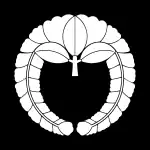Shikike
The Shikike (式家, Ceremonials House) was a cadet branch of the Fujiwara clan founded by Fujiwara no Umakai,[1] i.e., one of the four great houses of the Fujiwara, founded by the so-called Fujiwara Four, who were sons of Fujiwara no Fuhito.[2]
| Fujiwara Shikike 藤原式家 | |
|---|---|
 Mon: Sagarifuji | |
| Home province | Yamato Province |
| Parent house | Fujiwara clan |
| Titles | Various |
| Founder | Fujiwara no Umakai |
| Founding year | 8th century |
The name Shikike (式家) derives from the fact that the founder Umakai held the office of Shikibu-kyō (式部卿), or the head of the Shikibu-shō (式部省, "Ministry of Ceremonial").[3][4] Thus Shikike may be translated the "Ceremonials House."[5]
The other branches were the Nanke (the eldest brother Muchimaro's line), Hokke (Fusasaki's line), and the Kyōke (Fujiwara no Maro's line).[3]
Umakai's son Hirotsugu mounted a rebellion named after his name in 740, which ended with suppression and his death, spelling ill-fortune for the Shikike.[6] The Nanke then gained hegemony again (back from the non-Fujiwara Tachibana no Moroe) until Nakamaro mounted his own uprising.
Shikike came into ascendancy with Fujiwara no Momokawa.[5] The notorious Fujiwara no Kusuko who enticed and held sway over Emperor Heizei is also of the Shikike clan.[7]
See also
Notes
- Nussbaum, Louis-Frédéric et al. (2005). "Fujiwara no Umakai" at Japan Encyclopedia, p. 211, p. 211, at Google Books.
- Naoki, Kōjirō (1993). "4. The Nara state". In Hall, John W. (ed.). The Cambridge History of Japan: Ancient Japan (preview). Vol. 1. Cambridge University Press. pp. 248–. ISBN 9780521223522.
- Brinkley, p. 203., p. 203, at Google Books; excerpt, "Muchimaro's home, being in the south (nan) of the capital, was called Nan-ke; Fusazaki's, being in the north (hoku), was termed Hoku-ke; Umakai's was spoken of as Shiki-ke, since he presided over the Department of Ceremonies (Shiki), and Maro's went by the name of Kyō-ke, this term also having reference to his office."
- Jinnō Shōtōki (14th century), under Emperor Mommu:
武笠, 三 (Mukasa, San), ed. (1914). 神皇正統記(Jinnō Shōtōki), 讀史餘論 (Tokushi yoron), 山陽史論 (Sanyō shiron). 有朋堂書店. p. 64 – via Internet Archive.
三門は式部卿宇合の龍、式家といふ
{{cite book}}: CS1 maint: multiple names: editors list (link) - McCullough, William H. (1999). "Chapter 2: The Capital and its Society". In Hall, John Whitney; Shively, Donald H.; McCullough, William H. (eds.). The Cambridge History of Japan (preview). Vol. 2. Cambridge University Press. p. 26. ISBN 9780521550284.
- Nussbaum, "Fujiwara no Hirotsugu" at p. 211, p. 211, at Google Books
- McCullough 199, pp. 33–5
References
- Brinkley, Frank and Dairoku Kikuchi. (1915). A History of the Japanese People from the Earliest Times to the End of the Meiji Era. New York: Encyclopædia Britannica. OCLC 413099
- Nussbaum, Louis-Frédéric and Käthe Roth. (2005). Japan Encyclopedia. Cambridge: Harvard University Press. ISBN 978-0-674-01753-5; OCLC 58053128